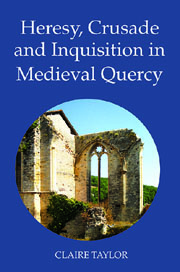Book contents
- Frontmatter
- Contents
- List of illustrations
- Dedication
- Acknowledgements
- Prefatory Note on Words
- List of Abbreviations
- Map 1 Medieval Quercy
- Map 2 Gourdon and its sphere
- The house of Gourdon
- Introduction
- 1 Investigating medieval Quercy: questions about sources
- 2 Medieval Quercy
- 3 War and its aftermath
- 4 ‘Heretical’ Quercy: the evidence gathered by c.1245
- 5 Heresy: a social and cultural life
- 6 Heresy and what it meant
- 7 The reshaping of Quercy
- Conclusion
- Bibliography
- Index
- YORK MEDIEVAL PRESS: PUBLICATIONS
1 - Investigating medieval Quercy: questions about sources
Published online by Cambridge University Press: 05 February 2013
- Frontmatter
- Contents
- List of illustrations
- Dedication
- Acknowledgements
- Prefatory Note on Words
- List of Abbreviations
- Map 1 Medieval Quercy
- Map 2 Gourdon and its sphere
- The house of Gourdon
- Introduction
- 1 Investigating medieval Quercy: questions about sources
- 2 Medieval Quercy
- 3 War and its aftermath
- 4 ‘Heretical’ Quercy: the evidence gathered by c.1245
- 5 Heresy: a social and cultural life
- 6 Heresy and what it meant
- 7 The reshaping of Quercy
- Conclusion
- Bibliography
- Index
- YORK MEDIEVAL PRESS: PUBLICATIONS
Summary
In this chapter we address the evidence and methodologies available for studying those medieval phenomena classified, in different contexts, by historians and by medieval clergy as ‘heresy’, and also for studying the medieval county of Quercy. We also note what has been established previously about Catharism and Waldensianism in Quercy.
Recording Society and Heresy in Medieval Quercy
Medieval Quercy corresponded closely to the modern departments of Tarnet-Garonne and Lot: that is to say, the region between the Dordogne and the Garonne-Tarn-Aveyron basin. Before the fourteenth-century creation of the diocese of Montauban, it corresponded essentially to the diocese of Cahors and to the most northerly part of the diocese of Toulouse. The boundary was in fact the gates of the quercinois town of Montauban.
In terms of conceptualising its social, political and confessional orientation in the high Middle Ages it makes sense to regard Quercy as having six different geographical spheres, contrasting with each other in some important ways. They are lower Quercy, the Vaux, the Bouriane and what we could call the Cahorsain-Lot, Limousin-Quercy and Eastern-Quercy (see Map 1, p. xii). The first three terms are names used by the people of the region historically. Identifying twelfth-century networks of lordship and religious affinity shows these distinctions to be appropriate for our purpose too. The latter three are terms I suggest as useful, again on the basis of identifying political and other features typifying these geographical spheres.
- Type
- Chapter
- Information
- Heresy, Crusade and Inquisition in Medieval Quercy , pp. 19 - 45Publisher: Boydell & BrewerPrint publication year: 2011



